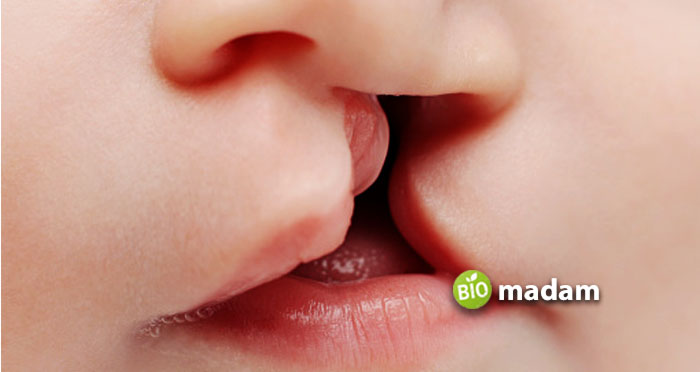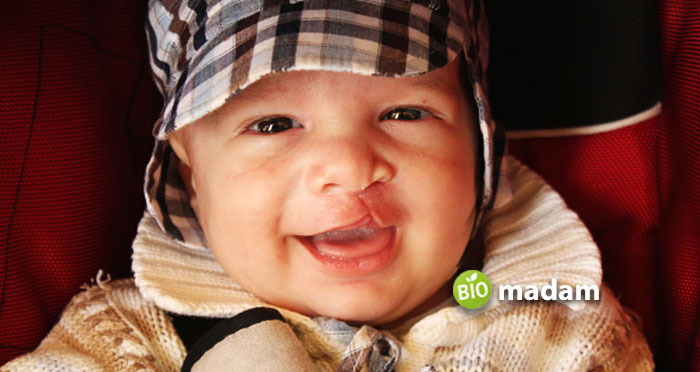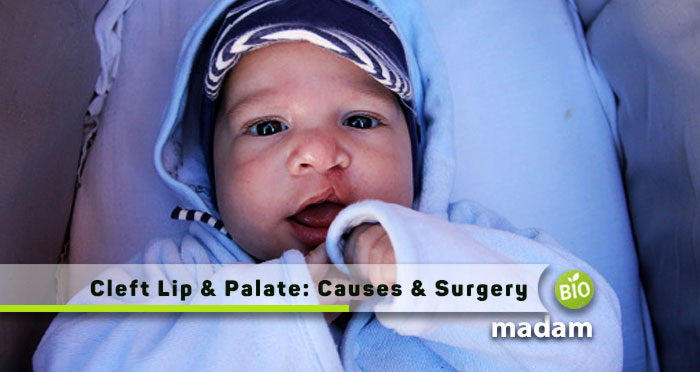Cleft lip and palate (also known as orofacial cleft) are the inborn defects caused by unattached nasal tissues to the upper jaw (cleft lip) and the opening of the roof of the mouth reaching the nose (cleft palate) during the fetal period. The typical feature of the defect is a cleft lip. In general, those defects lead to problems with appearance, speech formation, and nutrition. However, the psychosomatic development of a child is not violated.
The fact of the presence of these defects may be diagnosed with the help of ultrasound diagnostics during the fetal period. A cleft lip may be removed with the help of surgery (cheiloplasty). In cases when both defects (cleft lip and palate) are observed cheiloplasty; cleft rhinoplasty, palatoplasty, and tip rhinoplasty may be performed.
A cleft lip is a malformation in the development of the maxillofacial area. The lip is split into parts. About 0,04% of all children (among them are mostly boys) are born with such a defect. The formation of cleft lip and palate happens before the 8th week of pregnancy when the maxillofacial organs are developing. Facial cleft defects rarely appear to be isolated, in every 5th case, they serve as a component of severe inborn syndromes. Specialists in maxillofacial surgeries, dentists, speech therapists, and pediatrics deal with the correction of the cleft lip and restoration of all the functions.
The Cleft palate may present together or without a cleft lip and expresses in a gap in the roof of the mouth. A cleft palate disturbs eating and may cause ear infections and hearing violations.
Causes of Cleft Lip and Palate Development
The formation of both cleft lip and cleft palate is performed at the genetic level. Mutations of the TBX22-gene causing the cleft lip may be caused by toxicity, stress, analgesics and antibiotics, radiation, diseases, infections, drugs, smoking, and drinking alcohol Those factors are especially dangerous during the first 2 months of pregnancy.
Another factor causing cleft lip is late childbirth (35-40 years). A certain role in the development of these defects is performed by gynecological and somatic pathologies of the pregnant. The factors, influencing the formation of the cleft lip and palate are ranged in the following order: chemical (22.8%), psychiatric (9%) mechanical injuries (6%), biological (5%), physical (2%), and so forth. Determining the child with cleft lip or palate is possible during the ultrasound diagnostics. Parents who already have a child with a cleft lip should undergo medical-genetic screening.
Classification of the Cleft Lip
As a rule, the cleft is formed on the upper lip on one side of the central line. It is less frequently observed on both sides or on the lower lip. Usually, the cleft lip is placed on the left side. In case it affected both sides the presence of the protruding forward rostral bone of the upper jaw is admitted. There are full and partial forms of cleft lip. The partial cleft usually appears on one side in the formed recess in the lip.
The full cleft of the lip is characterized by a deep crack (cleavage) rising from the lip to the nose from one or both sides. This process is caused by nasal nonunion with the left and right maxillary. The defect may vary in depth and extension. In less severe cases splitting affects only the soft tissues of the lip. In severe cases, a defect is associated with the palatine bone and the bone of the upper jaw.
A cleft lip can occur in isolation but often is accompanied by other anatomical defects of the maxilla: Cleft hard and soft palate, nose deformities, etc. The establishment of the defect shape, and severity, in combination with other oral and maxillofacial pathology, allows for determining the tactics of treatment and methods of correction of the defect.

Appearances of Cleft Lip
A cleft lip is determined during the external examination of the child right after childbirth. The characteristic feature of a cleft lip is a deformation of the face accompanied by a cleft on one or both sides of the upper or lower lip. If the cleft lip is left untreated, it may decline a child’s self-esteem, eventually resulting in decreased self-reflection. Infants with cleft lips appear to have difficulties with sucking and swallowing. If the cleft lip is deep and big feeding through a nasal tube may be necessary. In the future due to teeth deformation and bite disrupting the process of chewing food may be violated.
The violation of dentition is characterized by teeth skipping or the presence of extra ones, incorrect growth angle of teeth, and tooth decay. In the case of those violations, orthodontic treatment and bite correction might be required. Sometimes the implantation or extraction of teeth could be necessary. Children with cleft lips have violations with the formation of the sounds which is manifested by speech function disorder (nasality) Those patients have unclear speech with a pronounced nasal sound ( snuffles) and problems with pronouncing consonants.
Principles of Cleft Lip Treatment
Cleft lip correction is performed during one or several plastic surgeries taking into account the features of each case of defect. Plastic correction of inborn cleft lip is prescribed for children that were born in a time and do not have any contradictions (combined defects of vital organs, birth injuries, acquired diseases, physiological jaundice, etc.).
Surgery removal of the cleft lip should be performed at the age of 3-6 months. In the case of the severe form, it may be done during the first days or the first month of a child’s life. But it should be done in cases where the child gained enough weight, and there are no signs of anemia, or intestinal pathologies.
There shouldn’t be any violations of the cardiovascular, nervous, and endocrine systems including their different types of glands. If the surgery is performed during the first two weeks after childbirth it will positively affect lip and nose development. Also, it will reduce psychological stress for parents. Also, it will reduce psychological stress for parents. However the anatomical size of the lips is too small at that age, some physiological functions are not completely developed and the tendency to hemorrhage is increased.
The restoration of the anatomical structure of the lip, as well as the elimination of nasal and palatal deformations, are achieved due to surgery. Also, the proper development of the maxillofacial system in childhood is possible after surgery. Cleft lip correction should be finished before the child turns three years old ( when the formation of speech takes place). Later speech therapy aimed at eliminating the speech defects and removal of the postoperative scar is performed. Taking into account the existing defects of lip, nose, palate, and of alveolar bone cheiloplasty and rhino-cheiloplasty.
However the anatomical size of the lips is too small at that age, some physiological functions are not completely developed and the tendency to hemorrhage is increased. The restoration of the anatomical structure of the lip, as well as the elimination of nasal and palatal deformations, are achieved due to surgery. Also, the proper development of the maxillofacial system in childhood is possible after surgery. Cleft lip correction should be finished before the child turns three years old ( when the formation of speech takes place). Later speech therapy aimed at eliminating the speech defects and removal of the postoperative scar is performed. Taking into account the existing defects of the lip, nose, palate, and alveolar bone cheiloplasty, rhino-cheiloplasty, and rhino-cheilo-gnathoplasty are held as reconstructive surgeries.
Ways of Cleft Lip Correction
Due to the primary cheiloplasty, the anatomic, esthetic, and functional features of the lip are restored. It is performed during the first days of a child’s life. Various methods of cheiloplasty are offered. The choice depends on the type of defect and the surgeon’s decision. Primary rhino-cheiloplasty is held for correcting the cleft lip, nose cartilage, and abnormal placement of muscles in the mouth cavity. It is technically a more complicated surgery and it is prescribed in cases of severe lip defects, nose deformations, and defects of the facial skeleton. Variations of performing rhino-cheiloplasty depend on individual features of the inborn defect.
To solve the problems of the restoration of anatomic usefulness lips, elimination of the nasal cartilage deformation, the formation of the high-grade muscular frame in the mouth, as well as the elimination of defects of the alveolar bone and the underdevelopment of maxilla on the side of the splitting the rhino-cheilo-gnathoplasty is performed. It allows the creation of conditions for the proper development of the upper jaw, nose, and lip.

Plastic Reconstructive Maxillofacial Surgery is able to help children born with a cleft lip nowadays, to achieve good aesthetic and functional long-term results of operations in 85-90% of cases and to adapt them to a full life in society. Surgeries are performed after a comprehensive examination of the child, confirming its functional readiness for surgical treatment. After the repositioning the sewing of split nasal and labial tissues takes place.
A Nostril swab is installed to protect the tissues from the food and slime and to prevent the narrowing of the nasal orifice. After the swab is removed a plastic tube is installed for 3 months into the nasal passage. It is done to prevent the narrowing and deformation of the nose wing. After 7-10 days the stitches are removed.
The incision on the lip is visible but it may become less expressed due to cosmetic procedures. In 70% of cases, additional surgeries may be required in older age. The functional and aesthetical achievements of cheiloplasty are visible only a year after the surgery took place. In some cases, the scar deformation of lips may develop and it may require plastic surgery of the mouth cavity.

Jeannie has achieved her Master’s degree in science and technology and is further pursuing a Ph.D. She desires to provide you the validated knowledge about science, technology, and the environment through writing articles.

